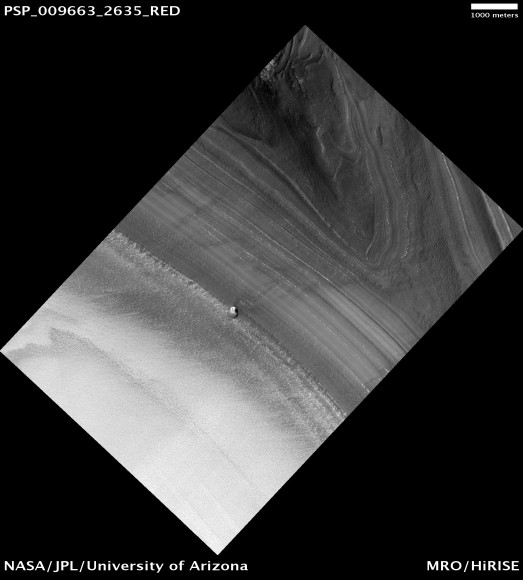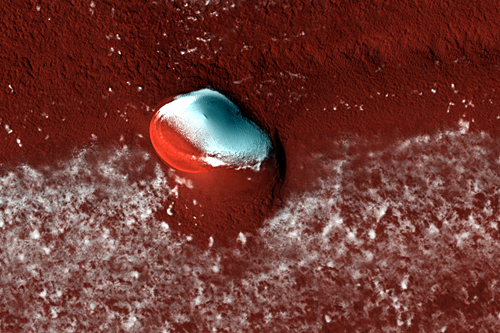[/caption]This striking view of the Martian surface shows a stark contrast (false colour) between ice deposits and layered deposits (composed mainly of ice, rock and regolith) on the edge of the polar ice cap. In the centre, there is a lone crater, approximately 200 meters in diameter, collecting a basinful of ice. The ice is thought to have been there for about 10,000 years.
However, there are some oddities in this scene. Why is the crater abnormally shaped? After all, craters are normally circular, not oyster shell-shaped. Why is it an isolated crater? On viewing the entire region, only one crater appears to be present for several kilometres. Does this mean the landscape is fairly young? If so, what geological processes are shaping the surface?
The High Resolution Imaging Science Experiment (HiRISE) on board the Mars Reconnaissance Orbiter (MRO) continues to return some of the most striking views from its Martian orbit. The camera can resolve objects less than a meter in diameter, picking out everything from sand dunes, eroding mesas, rolling rocks, avalanches (in action) to tiny secondary craters. These are some of the most detailed views we’ve ever had of the Red Planet’s surface. HiRISE can even keep an eye on our robotic explorers, like spotting Phoenix shortly after it landed and the tread marks of the rover Opportunity.

Although this image of a rather odd-looking crater in the North Polar Region of Mars may seem a little mundane when compared with the list of HiRISE accolades, it is no less important. It is the sole impact crater for miles, hugging the edge of the polar ice cap, carved into layered deposits of rock, soil and lumps of ice. Using the crater count as a guide (i.e. the lower the count, the younger the surface is) HiRISE scientists believe the layered deposits may only be a few million years old. This may sound like a long time, but for a planet thought to be geologically inactive, the resurfacing rate seems pretty rapid. In this case, it is also believed the ice deposits in the crater are only 10,000 years old.
Geological activity destroys evidence of craters, although this region will have been hit by a similar number of meteorite impacts as crater-covered regions, rapid processes appear to be constantly reshaping the landscape. It is thought that the ice flow rate would be quite low, but on observing the strange shape of the central crater, it seems it is being warped by the motion of the surrounding deposits. The bright white ice deposits inside the crater are being protected from ablation as it is being shaded from the Sun by the crater walls. This is a common feature in polar craters.
So much for Mars being a “dead” planet, then. As seen with the dynamic avalanche processes and rolling boulders, Mars is far from being geologically inactive…
Source: HiRISE


The six million dollar question: why is this crater noncircular, and why are many craters noncircular? A few million more: How can one crater overlap another without degrading the contacting rims even slightly? How come a crater viewed in cross section (some kind of rift split it) on Enceladus shows no subsurface disruption? How can an impact make polygonal or nearly perfect hexagonal craters? How can a multi-kilometer crater in Promethei Planum on Mars have a giant inscribed cycloid? Why do crater rays not always point to their putative origin, and why do they not always follow ground geodesics? These all point to nonimpact origins. The odd morphologies are found throughout the rocky and icy bodies of the solar system. In general, an impact acts like an explosion at or below ground level, and can only make circular or elliptical holes. I’m not buying the ground deformation argument.
Has anybody considered that perhaps the area was previously covered by a more extensive ice cap? The ice could have stopped the majority of meteor impacts and it could have shaped the blast that created this crater by limiting the direction of the blast. This would allow the other geologic features to be quite old, without being full of craters.
it’s not a crator, looking at the shadows, it’s raised – or so it looks to me
This doesn’t seem that mysterious to me, if I understand what the geology is like in this area. While many think of ice as rock that doesn’t move it really does, and if what this meteorite crashed into really is a regalith that has a high percentage ice…what we are looking at could actually be what is called a rock glacier, and a massive one at that. Since both glaciers and rock glaciers move over time, this could account for the distortion of the crater. It could also be, and probably is the source of the ice in the crater. I can just imagine a meteorite crashing into a glacier, creating a temporary lake from the impact, and then in the Martian environment quickly freezing over and staying there for a long long time. The only problem I see is that sublimation should have eliminated the ice over time…unless I am missing something, like a constant feeder source for the ice.
Based on the parallel lines outside the ice cap and the fact that we know the ice cap expands and recedes with the seasons, seems to me explains all the above, (except for Bills mysterious non-impact craters)! The icecap expands, both from ice deposition and expansion, pushes up a ridge, then recedes, leaving the ridge. The same action would have partly filled in the approaching side of the crater, as well as leaving a bit of ice that would have dissappeared by sublimation if the ice cap didn’t replenish it periodically.
Not to mention, soon filling in all craters, leaving the region “apparently young.”
It should have been obvious to most people that the non impact craters can be from moisture sublimation evaporting and creating a sink hole. Then the regolith falls into the crater, or the soil below is washed away beneath and, with nothing to support the regolith, you get a crater.
If I may follow up, when addressing the oyster we should look at the totality of crater morphologies. The mystery of all the different crater shapes is well addressed by the electric universe theorists (I have no affiliation) and one may access those thoughts in detail by googling the appropriate terms. It’s easy to hand-wave a blobby crater as being deformed by ground or ice movement (though I challenge the scientists to demonstrate a detailed 3d model of the process that does not use highly tunable variables to get the results). It’s far harder to hand-wave away the likes of the hexagonal craters that are numerous on the rocky and icy bodies. I have yet to hear any reasonable explanation of how impacts can produce polygonal and in some cases near-perfect hexagons. Don’t take my word….look carefully at the many Cassini photos of the Saturnian moons, for instance, and get out your straightedge and protractor.
It’s clearly an Astropop in the process of melting, which means the first life discovered on Mars will sadly be a crying child somewhere nearby.
Obviously aliens dug all those craters, Bill. Is that what you wanted to hear? Or are you one of those Electric Universe kooks?
this is simply a crash site of a low flying, high speed UFO. dont make it any more than it is.
I dunno Bill, an impact can easily act like an explosion above ground level as well, as events in Siberia have shown us. 🙂
It could be an impact by a double asteroid.
Sorry, no UFOs or aliens are in my thinking on craters and I am an adherent of experimental results having greater value than words or papers (and also of logic vs. name-calling). As I said, no affiliation, and I sense some skepticism so please, mr. formulaterp….tell me your take on how the hexagonal craters come to be caused by impact, if I may narrow the focus to see if there are any facts or even reasoned speculation behind your skepticism on this one facet of crater morphology, for example. I hope you will take the time to look at some Cassini or Messenger photos to see these multiple formations yourself. If you need a NASA photo reference, I will take the time to post a couple.
I left this comment on the HiRISE site:
Reference: http://hirise.lpl.arizona.edu/images/2008/details/cut/PSP_009663_2635_cut.jpg
What you are looking at is not a crater as such, but a tongue of ice that is above the surface. I would suggest that what we see is the result of a very slow ablation of ice rising to the surface.
Looking at the above image, you will see that the sunlight comes from the top right hand of the image, and beneath the lower left hand “edge” of the ice lip is a clear sunlight shadow that causes a glow of light underneath the edge. Thus the edge is not the rim of a crater, but instead is the edge of the lip above the surface.
I would also suggest that the prevailing wind is also from the same direction as the sunlight as the sublimed ice has created a “lake effect” light covering of snow downwind.
A water source under the ice has created a column of ice in the permafrost that has reached the surface and pushed itself above the surface. The prevailing wind, and sunlight in the same direction, has caused the ice to sublime towards the left of the image. On the sunward side, the ice is lower due to sublimation and ablation and that process has created the towering lip beyond the surface level with ice “snow” downstream on the surface of Mars itself.
——-
Returning to the matter of hexagonal shapes on a frozen surface, they are all caused by a known aspect of ice formation in that the ice crystals form hexagons, exactly the same thing with snow flakes.
My last post on this, I wanted to provide an easy verification that the hexagonal craters exist. There are other noncircular crater shapes too that are not easily explained by impact and subsequent deformation. Google the file name and you will get to NASA’s Planetary Photojournal. Responding to Chris’ well-considered post, polygons other than six-sided are not as easily explained by invoking the water molecule’s structure, which I don’t buy anyway because of the size disparity of known six-fold ice structures (snowflake scale) and the size of some of the craters (multi-kilometer).
PIA09830.jpg Dione – hexagons and other polygons. Two overlapping craters to the top and right of center illustrate that compression did not squeeze circular craters, as they are deformed in orthogonal directions.
PIA06156_modest.jpg Dione. The large crater at top is a well-formed hexagon. It escapes me how the symmetry of ice nanostructure extends to this crater size, which I estimate to be 50 km wide. Snowflakes I understand.
PIA08402.jpg Rhea, in 3D. A diochotron instability can produce near perfect hexagons and other polygons, and intermediate shapes.
PIA08173.jpg Rhea, many hexagons and other polygons.
PIA07583.jpg Another Rhea view with large obvious hexagons. Conventionally, these are viewed as impacts.